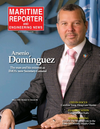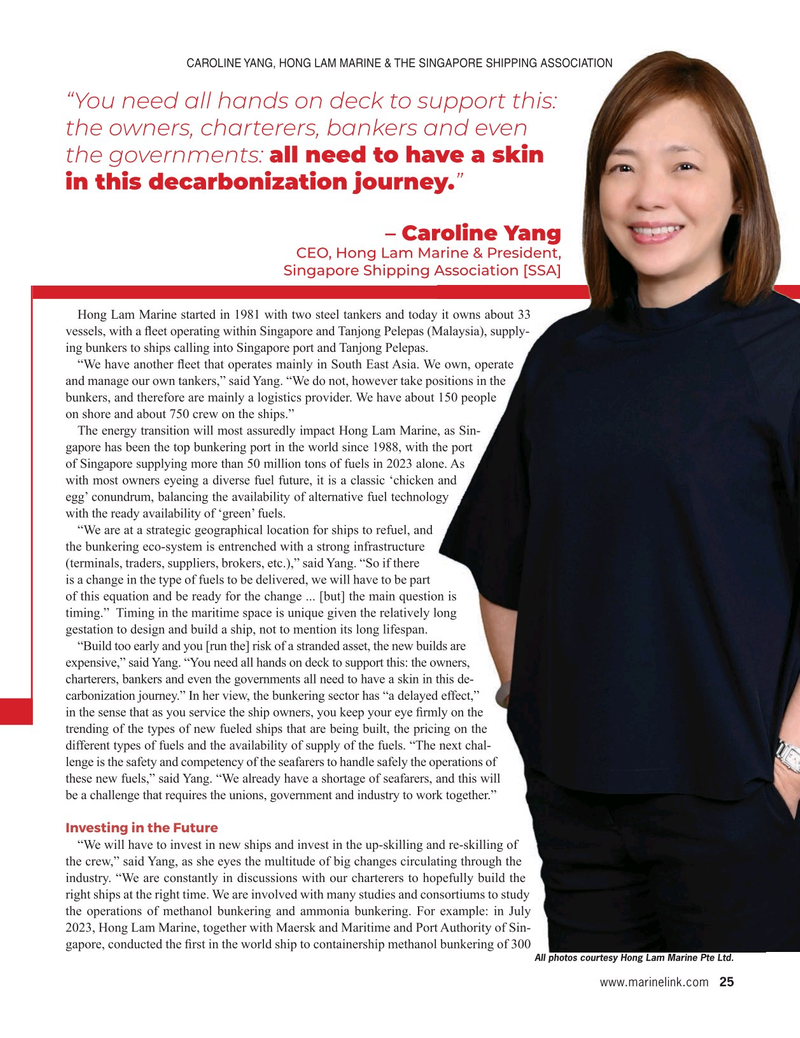
Page 25: of Maritime Reporter Magazine (May 2024)
Read this page in Pdf, Flash or Html5 edition of May 2024 Maritime Reporter Magazine
CAROLINE YANG, HONG LAM MARINE & THE SINGAPORE SHIPPING ASSOCIATION “You need all hands on deck to support this: the owners, charterers, bankers and even the governments: all need to have a skin in this decarbonization journey.” – Caroline Yang
CEO, Hong Lam Marine & President,
Singapore Shipping Association [SSA]
Hong Lam Marine started in 1981 with two steel tankers and today it owns about 33 vessels, with a ? eet operating within Singapore and Tanjong Pelepas (Malaysia), supply- ing bunkers to ships calling into Singapore port and Tanjong Pelepas. “We have another ? eet that operates mainly in South East Asia. We own, operate and manage our own tankers,” said Yang. “We do not, however take positions in the bunkers, and therefore are mainly a logistics provider. We have about 150 people on shore and about 750 crew on the ships.”
The energy transition will most assuredly impact Hong Lam Marine, as Sin- gapore has been the top bunkering port in the world since 1988, with the port of Singapore supplying more than 50 million tons of fuels in 2023 alone. As with most owners eyeing a diverse fuel future, it is a classic ‘chicken and egg’ conundrum, balancing the availability of alternative fuel technology with the ready availability of ‘green’ fuels.
“We are at a strategic geographical location for ships to refuel, and the bunkering eco-system is entrenched with a strong infrastructure (terminals, traders, suppliers, brokers, etc.),” said Yang. “So if there is a change in the type of fuels to be delivered, we will have to be part of this equation and be ready for the change ... [but] the main question is timing.” Timing in the maritime space is unique given the relatively long gestation to design and build a ship, not to mention its long lifespan. “Build too early and you [run the] risk of a stranded asset, the new builds are expensive,” said Yang. “You need all hands on deck to support this: the owners, charterers, bankers and even the governments all need to have a skin in this de- carbonization journey.” In her view, the bunkering sector has “a delayed effect,” in the sense that as you service the ship owners, you keep your eye ? rmly on the trending of the types of new fueled ships that are being built, the pricing on the different types of fuels and the availability of supply of the fuels. “The next chal- lenge is the safety and competency of the seafarers to handle safely the operations of these new fuels,” said Yang. “We already have a shortage of seafarers, and this will be a challenge that requires the unions, government and industry to work together.”
Investing in the Future “We will have to invest in new ships and invest in the up-skilling and re-skilling of the crew,” said Yang, as she eyes the multitude of big changes circulating through the industry. “We are constantly in discussions with our charterers to hopefully build the right ships at the right time. We are involved with many studies and consortiums to study the operations of methanol bunkering and ammonia bunkering. For example: in July 2023, Hong Lam Marine, together with Maersk and Maritime and Port Authority of Sin- gapore, conducted the ? rst in the world ship to containership methanol bunkering of 300
All photos courtesy Hong Lam Marine Pte Ltd. www.marinelink.com 25
MR #5 (18-33).indd 25 5/3/2024 8:40:18 AM

 24
24

 26
26
